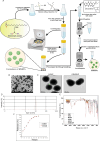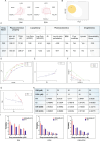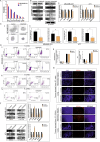Exosome-sheathed porous silica nanoparticle-mediated co-delivery of 3,3'-diindolylmethane and doxorubicin attenuates cancer stem cell-driven EMT in triple negative breast cancer
- PMID: 38796426
- PMCID: PMC11127288
- DOI: 10.1186/s12951-024-02518-0
Exosome-sheathed porous silica nanoparticle-mediated co-delivery of 3,3'-diindolylmethane and doxorubicin attenuates cancer stem cell-driven EMT in triple negative breast cancer
Abstract
Background: Therapeutic management of locally advanced and metastatic triple negative breast cancer (TNBC) is often limited due to resistance to conventional chemotherapy. Metastasis is responsible for more than 90% of breast cancer-associated mortality; therefore, the clinical need to prevent or target metastasis is immense. The epithelial to mesenchymal transition (EMT) of cancer stem cells (CSCs) is a crucial determinant in metastasis. Doxorubicin (DOX) is the frequently used chemotherapeutic drug against TNBC that may increase the risk of metastasis in patients. After cancer treatment, CSCs with the EMT characteristic persist, which contributes to advanced malignancy and cancer recurrence. The latest developments in nanotechnology for medicinal applications have raised the possibility of using nanomedicines to target these CSCs. Hence, we present a novel approach of combinatorial treatment of DOX with dietary indole 3,3'-diindolylmethane (DIM) which is an intriguing field of research that may target CSC mediated EMT induction in TNBC. For efficient delivery of both the compounds to the tumor niche, advance method of drug delivery based on exosomes sheathed with mesoporous silica nanoparticles may provide an attractive strategy.
Results: DOX, according to our findings, was able to induce EMT in CSCs, making the breast cancer cells more aggressive and metastatic. In CSCs produced from spheres of MDAMB-231 and 4T1, overexpression of N-cadherin, Snail, Slug, and Vimentin as well as downregulation of E-cadherin by DOX treatment not only demonstrated EMT induction but also underscored the pressing need for a novel chemotherapeutic combination to counteract this detrimental effect of DOX. To reach this goal, DIM was combined with DOX and delivered to the CSCs concomitantly by loading them in mesoporous silica nanoparticles encapsulated in exosomes (e-DDMSNP). These exosomes improved the specificity, stability and better homing ability of DIM and DOX in the in vitro and in vivo CSC niche. Furthermore, after treating the CSC-enriched TNBC cell population with e-DDMSNP, a notable decrease in DOX mediated EMT induction was observed.
Conclusion: Our research seeks to propose a new notion for treating TNBC by introducing this unique exosomal nano-preparation against CSC induced EMT.
Keywords: 3,3′-diindolylmethane; Cancer stem cell; Doxorubicin; EMT; Exosome; TNBC.
© 2024. The Author(s).
Conflict of interest statement
The authors declare that they have no known competing financial interests or personal relationships that could have appeared to influence the work reported in this paper.
Figures







References
MeSH terms
Substances
Grants and funding
LinkOut - more resources
Full Text Sources
Research Materials

